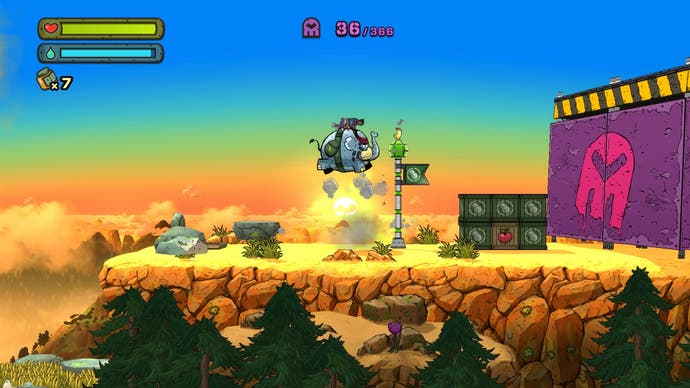Tembo the Badass Elephant review
Fifty shades of grey.
If I were Sonic the Hedgehog, I'd be pretty worried right now. After a string of flops and failed reboots, Sega's iconic mascot is looking more like a has-been than a go-getter. In fact, it's got so bad that they're openly auditioning for replacements, with developer Game Freak stepping forward with the Sega published Tembo the Badass Elephant.
In terms of physicality, Tembo couldn't be more different to his bright blue predecessor. He's a chunky grey military hero (who just happens to have a trunk and large ears) rather than a sneaker-melting speedy rebel, but in gameplay there are notable similarities.
Tembo is pretty speedy for an elephant, with his main mode of both locomotion and attack being a thundering charge. This is enough to demolish scenery items and send enemy soldiers flying, and while it's not as fast as Sonic's dash, it's certainly more fun to plough through buildings, pillars, cars and trees. They also share a tumbling spin attack, which allows Tembo to smash down through weaker floor areas and even bounce, which is quite a feat when you weight several tons.
Our elephantine hero proves remarkably agile, in fact. He has a generous jump, which can be extended for a short period by keeping the button held down. This makes him paddle furiously in mid-air, offering just enough extra distance to reach more distant platforms or clear larger hazards.

It's these aspects which dominate the game's early stages, and they make for a compelling introduction. Navigating and demolishing your way through the first world is a tactile pleasure thanks to the game's cartoon physics, which are supported by the distinctive visual style. This is a game that looks like it could have stomped off the drawing board at a kids TV network. Indeed, the visual style is so similar to Disney's cult animated show Gravity Falls that I had to check it wasn't the same artist. Derivative as it may be, it's still a fantastically appealing look and the inclusion of energetic on-screen sound effects makes it feel even more alive.
Other abilities are available to you, and lend a more puzzle-based tone to the game as it progresses. You can squirt water from your trunk to put out fires, though anything that burns blue will reignite after a short while. Water can also be used to turn seeds into useful platforms and turn cranks and wheels to raise doors. Again, these will revert back to their original state after a few seconds.
You can probably already guess what sort of challenges these features create, and that's ultimately what starts to pull Tembo down from his initial high. There are conveyor belts. Timed dashes to slide under doors. Exploding crates. Hidden areas lurking behind the scenery. It's not that it's wrong to dust off such trusty old platform gaming concepts, but that Tembo's unique elephant qualities are only occasionally used to make them seem fresh.
The familiarities don't stop there. On top of the echoes of Sonic, there are sections that feel like Rayman, courtesy of that jump-and-glide mechanic, and cannons and swings seemingly imported direct from Donkey Kong Country. For every moment of enjoyable platform game design - and there are many - there are plenty that are also fairly rote, made interesting more by the game's aesthetic than its mechanics.
Tembo's long term weaknesses only really become apparent when you hit one of the gateways between the different areas. In each level there are a set number of enemies - killing as many as possible is your goal, and the path to the next area only opens up once you've clobbered enough. The total required is pretty tight, and while you don't have to get every single enemy, it's not far off. Don't be surprised if you find yourself having to replay levels, hunting for ten or twenty bad guys you missed first time through.

Trouble is, playing the levels a second time isn't nearly as much fun. Later stages have moments that feel more like they're designed to trick you rather than challenge you - with instant death hazards placed cynically at the end of sections designed to get you building up momentum by trampling and crashing. The game basically has two speeds - careful manoeuvring and wanton destruction - and the gear change between the two can be frustrating.
The level design strives for a tricky balance between encouraging you to rampage, and punishing you for getting too carried away. It's so easy, and so much fun, to smash through everything that you'll sometimes find you've destroyed things that could have been used to reach a secret area. Equally, the game isn't fond of backtracking, so if you miss something there's often no way to go back. When you're replaying in order to find enemies you missed, being herded past an area you needed to explore gets pretty annoying.
As such, Tembo is at his best in the first few hours, when that eye-catching cartoon style is still fresh and you're free to wallow in his more destructive tendencies. It would be inaccurate to say the game gets worse the further you get, but it does start to lose its lustre. It lacks the deft strokes of genius that allow Mario to continue remixing the same elements after 30 years, and it doesn't quite have the ruthless precision that makes a Mega Man or Rayman Legends so damnably moreish.
Not being able to live up to such lofty rivals is no great shame, of course. Tembo is simply a very pretty, and pretty good, game, albeit one that never quite lives up to its early promise. That alone makes it the best platformer that Sega has released in years, and for that Game Freak deserves our thanks.










